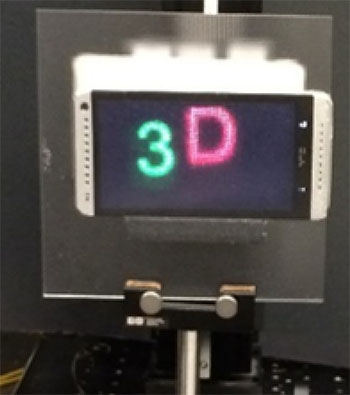
Optical 3-D integral imaging display setup using a smartphone and a microlens array. [Image: Markman et al., Optica 1, 332 (2015).]
Smartphone users are very familiar with QR codes—the square patterns in advertisements, posters and billboards that push users to a specific website with a wave of the smartphone’s camera. Now, a team of scientists at the University of Connecticut, USA, has found another use for the codes: as a data package for 3-D images that can be displayed on mobile devices (Optica, doi: 10.1364/OPTICA.1.000332). The team believes that the method, which doesn’t require Internet access, could point to new possibilities for secure 3-D visual communication.
In particular, the new study presents a scheme for “integral” 3-D imaging, which is accomplished without the aid of special “3-D glasses,” and instead uses an array of microlenses. Each of the tiny lenses occupies a slightly different orientation from the others, in a configuration analogous to an insect’s compound eye.
The scene to be rendered in 3-D is captured as a series of 2-D “elemental images” from the perspective of each individual microlens, with each elemental image capturing both angular and intensity information for compression, encryption and storage in a QR code. Playing back the image on a smartphone involves decoding the sequence of QR codes using conventional QR software, and piping the signal back through a similar microlens array that sits atop the smartphone screen to reconstruct the 3-D rendering.
The scientists see particular advantages in the system’s security: since the data are embedded in the QR codes themselves, rather than on a linked Internet site, the visual information can be decoded and displayed without recourse to the Internet and without exposure to potential malicious code online. The researchers also applied an alternative compression and encryption technique involving photon counting, and found that security could be improved still further, at some cost to image quality. They’re working now on refining the process to provide the best balance among security, compression and 3-D clarity.
While the team has accomplished an end-to-end proof of principle for the approach, production use of the technology on mobile devices will require creation of additional decompression and decryption apps. Still, the researchers believe that these should be easily developed, and that the technique could be in common use in the not too distant future. “This is definitely something,” says senior author Bahram Javidi, “you can look forward to accessing on your smartphone.”
